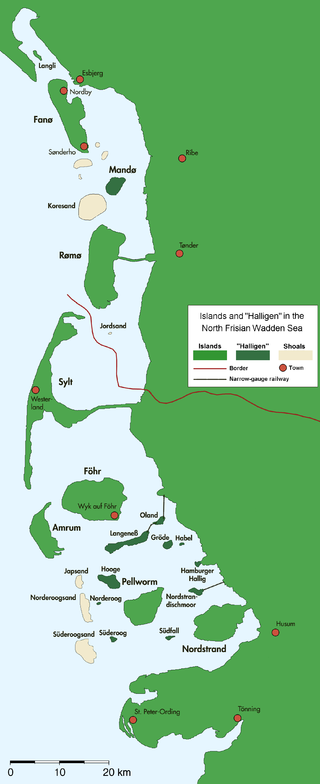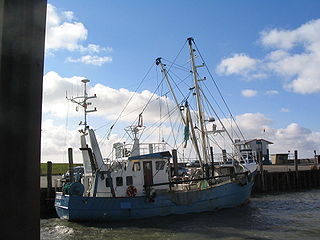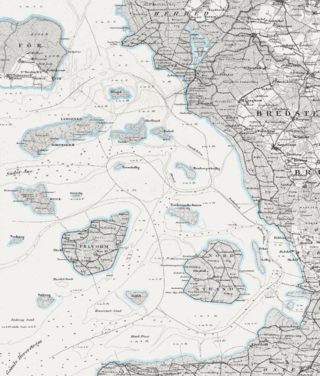
Rungholt was a settlement in North Frisia, in what was then the Danish Duchy of Schleswig. The area today lies in Germany. Rungholt reportedly sank beneath the waves of the North Sea when a storm tide hit the coast on 15 or 16 January 1362.

Nordfriesland, also known as North Frisia, is the northernmost district of Germany, part of the state of Schleswig-Holstein. It includes almost all of traditional North Frisia, as well as adjacent parts of the Schleswig Geest to the east and Stapelholm to the south, and is bounded by the districts of Schleswig-Flensburg and Dithmarschen, the North Sea and the Danish county of South Jutland. The district is called Kreis Nordfriesland in German, Kreis Noordfreesland in Low German, Kris Nordfraschlönj in Mooring North Frisian, Kreis Nuurdfresklun in Fering North Frisian and Nordfrislands amt in Danish.

The North Frisian Islands are the Frisian Islands off the coast of North Frisia.

Husum is the capital of the Kreis (district) Nordfriesland in Schleswig-Holstein, Germany. The town was the birthplace of the novelist Theodor Storm, who coined the epithet "the grey town by the sea". It is also the home of the annual international piano festival Raritäten der Klaviermusik founded in 1986.

is a municipality in the district of Nordfriesland, in Schleswig-Holstein, Germany.

is a peninsula and former island in North Frisia on the North Sea coast of Germany. It is part of the Nordfriesland district in the federal state of Schleswig-Holstein. Its area is 50 km² and its population is 2,300. Nordstrand has two municipalities, Nordstrand and smaller Elisabeth-Sophien-Koog, which are part of the Amt Nordsee-Treene.

Gottorf Castle is a castle and estate in the city of Schleswig, Schleswig-Holstein, Germany. It is one of the most important secular buildings in Schleswig-Holstein, and has been rebuilt and expanded several times in its over eight hundred years of history, changing from a medieval castle to a Renaissance fortress to a Baroque palace.

The Burchardi flood was a storm tide that struck the North Sea coast of North Frisia, Dithmarschen and southwest Jutland on the night between 11 and 12 October 1634. Overrunning dikes, it shattered the coastline and caused thousands of deaths and catastrophic material damage. Much of the island of Strand washed away, forming the islands Nordstrand, Pellworm and several halligen.

North Frisia is the northernmost portion of Frisia, located in Schleswig-Holstein, Germany between the rivers Eider and Wiedau. It also includes the North Frisian Islands and Heligoland. The region is traditionally inhabited by the North Frisians.

Reußenköge is a sparsely populated municipality in the district of Nordfriesland, in Schleswig-Holstein, Germany. It is situated directly adjacent the shoreline of the North Sea coast, in a driving distance of in between 15 up to 29 km northwest of the county-capital city of Husum.

Sankt Peter-Ording is a popular German seaside spa and a municipality in the district of Nordfriesland, in Schleswig-Holstein, Germany. It is the only German seaside resort that has a sulphur spring and thus terms itself "North Sea spa and sulphur spring". By overnight stays, St. Peter-Ording is the largest seaside resort and has the most overnight stays in the state of Schleswig-Holstein.

Karrharde was an amt in the district of Nordfriesland, in Schleswig-Holstein, Germany. It was situated on the border with Denmark, approx. 35 km north of Husum, and 25 km west of Flensburg. Its seat was in Leck, itself not part of the amt.

Südfall is a small island in the Wadden Sea off the west coast of Schleswig-Holstein, Germany, one of the ten German Hallig islands. It has a permanent population of two people. It covers an area of 0.56 square kilometres (0.22 sq mi) and is administratively part of Pellworm Municipality.
Strand Frisian was a dialect of the North Frisian language which was originally spoken on Strand island, Duchy of Schleswig. Strand was destroyed in the Burchardi flood of 1634 with its remnants forming the islands Pellworm and Nordstrand which are now part of Germany. Strand Frisian is counted among the mainland group of North Frisian dialects.

Edoms Hundred was a mediaeval hundred located in the southern part of North Frisia in the Danish region of Southern Schleswig, part of the Frisian Uthlande. It encompassed the eastern part of the island of Strand, which sank in 1634 during the Burchardi flood, including some of the land which now comprises the peninsula of Nordstrand. Edoms Hundred bordered the other so-called Five Hundreds or Strand Hundreds on the island: Beltring Hundred to the north, Pellworm Hundred to the west, Southern Goes Hundred to the east, and Lundenberg Hundred to the south.

Hainshallig was a small Hallig in the North Frisian Wadden Sea, located east of the Hallig of Hooge, that was flooded and sank in 1860. At the time, Hainshallig was leased to a Hooge resident as part of a leasehold estate and was used for the production of hay. A levee may have once led from Hooge to Hainshallig. The area belonged to the Duchy of Schleswig, which was a fiefdom of the Danish crown, now Germany.

Beltring Hundred was a mediaeval hundred located in the southern part of North Frisia in the Danish region of Southern Schleswig, part of the Frisian Uthlande. It encompassed the northern part of the island of Strand, which sank in 1634 during the Burchardi flood. Some of the land of Beltring Hundred survived the flood, however, and became the Hallig of Nordstrandischmoor as well as the site of the modern municipality of Ockholm. Beltring Hundred was one of the so-called Five Hundreds or Strand Hundreds on the island, the others being Edoms Hundred, Pellworm Hundred, Southern Goes Hundred, and Lundenberg Hundred.

Pellworm Hundred was a mediaeval hundred located in the southern part of North Frisia in the Danish region of Southern Schleswig, part of the Frisian Uthlande. It encompassed the western part of the island of Strand, which sank in 1634 during the Burchardi flood. Pellworm Hundred was one of the so-called Five Hundreds or Strand Hundreds on the island, the others being Edoms Hundred, Beltring Hundred, Southern Goes Hundred, and Lundenberg Hundred. The land that remained of the hundred after the flood is now largely geographically part of the modern island of Pellworm in the German state of Schleswig-Holstein.

Lundenberg Hundred was a mediaeval hundred located in the southern part of North Frisia in the Danish region of Southern Schleswig, part of the Frisian Uthlande. Lundenberg Hundred was one of the so-called Five Hundreds or Strand Hundreds on the island, the others being Edoms Hundred, Beltring Hundred, Southern Goes Hundred, and Pellworm Hundred. It encompassed the southeastern part of the former island of Strand, between what are now the peninsulae of Nordstrand and Eiderstedt.

The Bay of Husum, Husum Bight or Husum Bay is a bay on the North Sea coast of the German state of Schleswig-Holstein. Its German name is used for marketing the holiday region around the town of Husum.


















